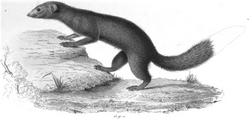Taxonomy
The brown-tailed mongoose was first described in 1837 by French zoologist Isidore Geoffroy Saint-Hilaire under the names Galidia unicolor and Galidia olivacea. He placed both in the genus Galidia, together with the ring-tailed mongoose (Galidia elegans), [3] which is now recognized as the only species of that genus. [4] However, the name unicolor had been a misprint for concolor, and the name was corrected in an erratum and in a later note by Geoffroy Saint-Hilaire. [5] In 1865, [Note 1] John Edward Gray placed concolor and olivacea in their own subgenus of Galidia, which he called Salanoia . [7] In 1882, St. George Jackson Mivart also separated olivacea and concolor from Galidia, and placed them in a separate genus Hemigalidia, without mentioning Salanoia. [8] In his 1904 Index generum mammalium, Palmer noted that Salanoia, the first name to be published, was the proper name for the genus. [9] Although Glover Morrill Allen, in 1939, still listed two species, which he called Salanoia olivacea and S. unicolor, [10] by 1972 R. Albignac recognized a single species only, which he called Salanoia concolor. [11] A second species of Salanoia, Salanoia durrelli , was described in 2010. [12]
This page is based on this
Wikipedia article Text is available under the
CC BY-SA 4.0 license; additional terms may apply.
Images, videos and audio are available under their respective licenses.


